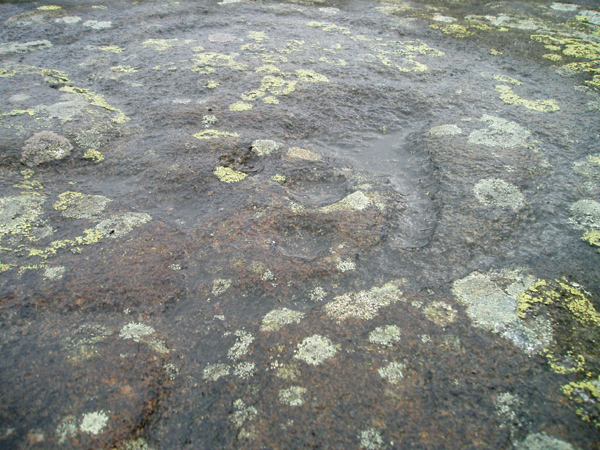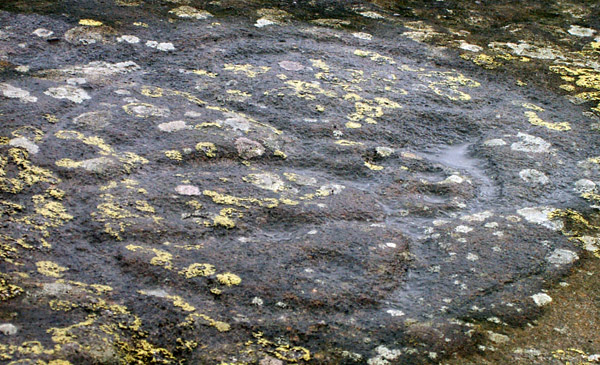
Graffiti attack suffered sometime in mid to late August 2012. Unfortunately, ‘Blakey’ (just off image to right) was cut deep into cup and ring motif.

Graffiti attack suffered sometime in mid to late August 2012. Unfortunately, ‘Blakey’ (just off image to right) was cut deep into cup and ring motif.

4-9-2008
www.briankerrphotography.co.uk

4-9-2008
www.briankerrphotography.co.uk

4-9-2008
www.briankerrphotography.co.uk

Title: Hangingstones 2
Medium: Digital Art
Description: Inspired by the Hangingstones Prehistoric Rock Carvings, Ilkley Moor.

24/11/05
Rock art virgin enjoying the carvings.

24/11/05
large basin.

24/11/05

24/11/05

24/11/05

14-10-05
View over Ilkley
.o0O0o.

14-10-05
.o0O0o.

14/10/05

14/10/05

14/10/05

14/10/05

The two bowls at the Hangingstones.

The Fairie’s Kirk (or Parlour). A recess under the Hangingstones outcrop.



September 2000; view over the rock art panel to the SW with the quarry in the background.

The unusual motif photographed in September 2000

Carvings on the eastern section of the outcrop.

The most easterly carving on the outcrop.

The middle set of carvings on the outcrop.


The Hangingstones outcrop. The area under the over-hang is known as the Fairie’s Parlour, or sometimes as the Fairie’s Kirk. Legend has it that the Anglo-Saxon’s attempted to build a church nearby, but each morning returned to find the stones moved. They eventually built the church in Ilkley.
The name Fairie’s Kirk could be a folk memory of the original uses of the rock and it’s carvings.

Hangingstones carving circa 1987.

Hangingstones carving circa 1987.

The larger of two ‘bowls’ at Hanginstones.

One of two ‘bowls’ on Hangingstones.

Worn carving on eastern section of outcrop.

Large worn cup and ring marks.

Main carvings at the Hanginstones.

The ‘Waterboatman’ at Hangingstones Quarry

Rock Art at Hangingstones Quarry


the more obscure carving looking towards the main motif


08/03. Looking back to the main panel.

08/03. The carving to the NE.

08/03

08/03. More well placed graffiti.........


Looking west

Looking northwards

View north across Ilkley and the Wharf Valley

Besides the well know carvings at the Hangingstones are two carved bowls set back a little from the main outcrop. They seem just too perfect to be the result of weathering.
Also, if I ever encounter the person who did the knotwork carving on the western rock surface, I’m gonna kick them really hard!
After spending the hottest day of the year traipsing all over the moor, I was started to become a little jaded. We had passed a path down to the Cow and Calf Pub and my mind was on the prize – a pint.
This was to be our last site of the day and to be honest with you I just wanted to get it done and head for the pub.
When we got to the quarry site I stopped for a rest but Stu assured me that it was just up a wee hill and then we were done, so once again I dragged my weary arse up the path. At the top of the path the first carving came into view and then as I looked around.......JESUS! I just wasn’t prepared for this.
During the day Stu and I had discussed the many possible interpretations of the various motifs on the rocks of the moor. Stu had even identified a possible map on one stone. But these are beyond interpretation and the only thing we could come up with was ...shamanic.
Stu had christened one of the carvings ‘the waterboatman’ which fits it perfectly.
If you only have time to visit one set of carvings make sure these are the one.
Back to these carvings for the 2nd time this week, this time with Fitzcolrado. And true to form he found the carvings to the south of the main group mentioned by Stan Beckensall and Chris Collyer. Only he found it to the NE of the group, on the larger section of the outcrop.
I reckon Stan’s picture shows whats up on the Hanging Stones, but doesn’t show it where it really is on the ground.
These are excellent carvings but are in a pretty bad place to be on the moor.
It would bea good idea to get a copy of the diagram posted on this page or something similar, there is quite alot of recent graffiti scratched all over the shop and it gets a bit tricky to see what’s what. Unbelievable really when you think they’re in a quarry full of shag rocks to piss on.
This has to be one of my favourite carvings on the moor despite the fact that it is close to a fair bit of passing human traffic and noise and has been the subject of vandalism in the form quarrying, as well as peoples names and even modern celtic patterns chipped out of the rock. The motifs though amaze me – I think this is only the second time I’ve visited, the first time I managed to completely miss a large section of the carvings and there may be more here that I haven’t yet recognised. The largest motif consists of a deep central cup with double joined arcs and extending grooves, one of which has a peculiar kink in it as it curves away to the west before turning sharply to the north. Just to the east of the pattern a deep groove runs northwest-southeast. On either side of it are about half a dozen cups, 3 rings and several unfinished rings or grooves. To the west is the second motif that seems to have been damaged by quarrying, again it has an almost central cup, this time with a ring that a doesn’t quite meet and a pair of grooves extending from either side that curve in and also do not quite meet. Through the middle of these 2 elements is a half circle groove which also has an uncut centre – why were these 3 elements left with uncut centres? Between the 2 main motifs, 5 cups and a small groove form a triangle – Stan Beckensall shows a further motif to the south but I couldn’t find it.
In my last fieldnote for this site I mentioned that normal maps are of no use on the moor and the GPS reigns supreme. At the time and with the maps I had this was largely true although the comment now seems rather ignorant and cringeworthy. Yes, a GPS will take you close to the stones but it is no replacement for a decent map – I would definitely recommend a visit to magic.gov.uk to get some printouts at 1:5000 or 1:10000 which accurately show the many tracks over the moor as well as the locations of most of the stones and other scheduled monuments.
On Rombalds moor normal OS grid refs make little sense -this is GPS territory! My recording is SE1282146763. Without GPS the easiest way to get to the Hanging Stones carvings is to head out of the carpark, walk past the Cow and Calf rocks, take a right turn and follow the track to the old quarry. Clamber around on flat outcrops of rock and you should come across this strange series of cups, rings, lines, a 3 armed spiral and the main central feature. This consists of a central cup, concentric rings, with possible cups, ans a strange squigly outline. Is it some kind of map?
Just to mess the place up, some idiot has carved a celtic knotwork pattern into the rock just a few feet away. OK, so they’ve done a nice job, but this ain’t the place for it...
Under the famous Hanging Stone, with its mystic “cup and ring” sculptures, the rock is hollowed out forming a deep overhanging cavity, and I am told that this ancient rock-shelter has been known from time immemorial as “Fairies’ Kirk,” and traditions of its having been tenanted by those tiny sprites, the fairies, still exist among old people in the neighbourhood. When the Saxons established themselves at Ilkley they were going to build a church up here, but the fairies strongly resented. They would have none of it, and so their little temple was erected in the vale below. The fairies distrust any intrusion upon their own sacred places [...] I cannot go into all the details I have heard of the antics of these mysterious little people here and in the neighbouring gills.
From Upper Wharfedale by Harry Speight (1900). He also writes:
Hanging Stones (west of Cow and Calf), cup and ring marked. Some vandal has been imitating the primeval sculptures by chiselling on the same stone, but the freshness of the recent work is at once seen. It is to be regretted that quarrying has been permitted to get so near this exceedingly valuable monument of antiquity, a relic which, as the ages roll on, must gather an ever-deepening interest.
The small recess beneath the Hangingstones is known as the Fairie’s Parlour.
” in 1865 a visitor to Ben Rhydding Hydro, a Mr Terry, was watching men prepare for quarrying, when he noticed some fine rock carvings in danger of being destroyed. He informed Dr. McLeod at the Hydro who appealed to Squire Middleton to stop the quarying. The carvings cover 17m & are of an unusual design. There are many cups, rings & grooves, 3 larger than usual.”
From “Walks Around Cup & Ring Stones”
A booklet published by Ilkley Tourist Information Centre
Available at the Cow & Calf tea kiosk for 50 new pence.
Hanging Stones on BRAC Updated


































































































































